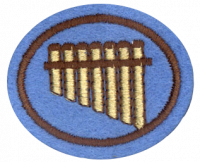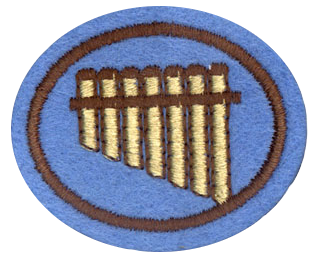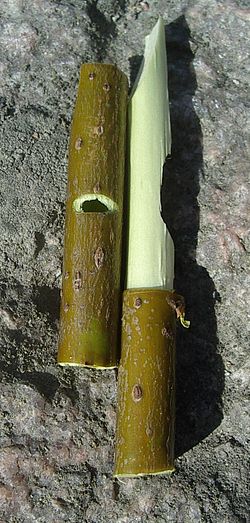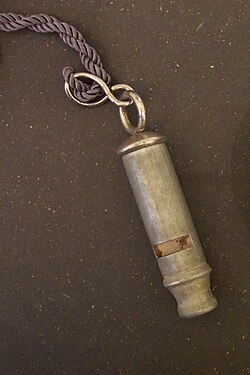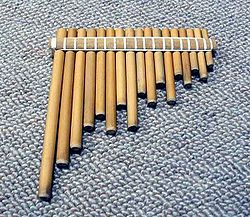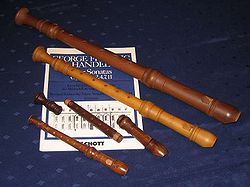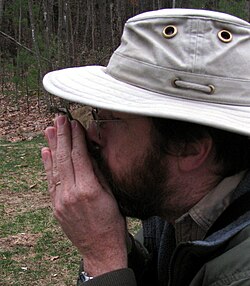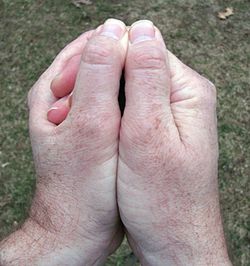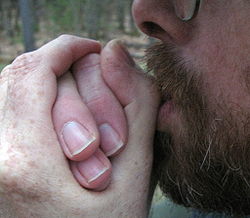Especialidades JA/Silbatos/Respuestas
1
2
3
Sap is a liquid that circulates within the sapwood of trees. Sap rises up from the roots. Sap contains water and minerals; in the spring it also contains sugars and stimulates the growth of the tree.
4
Willow and Maple trees (especially striped maple, Acer pensylvanicum) are considered the best for making whistles. Willow is often more plentiful than maple, and they grow back very quickly when cut. Some prefer maple because it is straighter and has fewer knots. Maples also grow back quickly if cut from a large stump.
Other trees that can be used for whistle-making include:
- Alder, aspen, and poplar
- These species can also be used for making slip-bark whistles. As with any slip-bark whistle though, they should be made in the spring or early summer when the sap is up. After that, it's too difficult to slip the bark off the wood.
- Elderberry
- Elderberry has a pithy core that can be easily removed. In this case, the bark is not used as the outer sheath, but rather, the whole twig is. You must find another piece of wood to fit tightly into the pith and shave off the top edge of it to make the whistle.
- Sumac
- If you select a sumac tree, make sure it is not a poison sumac tree (Rhus vernix). All parts of the poison sumac contain the same resin as poison ivy and can cause a person to suffer from an itchy rash. Poison sumac has white berries. If the sumac has red berries, it is OK to use and will not cause a rash.
5
5a
A tube whistle is a small, very loud whistle made of a metal tube closed at one end. These are most familiar as the whistles carried by the English Bobbies (policemen).
5b
The pan whistle is an ancient musical instrument based on the principle of the closed tube, consisting usually of five or more pipes of gradually increasing length (and, at times, diameter). The pan whistle (or pan flute) has long been popular as a folk instrument, and is considered the first mouth organ, ancestor of both the pipe organ and the harmonica. The pan flute is named for its association with the rustic Greek god Pan. The pipes of the pan flute are typically made from bamboo or giant cane; other materials used include wood, plastic, and metal.
5c
Flute whistles are open at both ends and usually have a series of holes along the length of the tube. The pitch of the flute whistle can be changed by closing one or more of the holes.
6
- Pea Whistle
- Pea whistles are used by referees in many sports. It is a whistle with a small ball trapped inside which makes a rattling sound as the whistle resonates.
- Transverse Flutes
- Transverse flutes are a form of whistle used in modern orchestras. They are operated by blowing across a hole located on the mouthpiece.
- Tin Whistle
- This is another form of musical whistle, but unlike the transverse flute, it is end-blown and has only six holes. It is an important instrument in Irish folk songs.
- Dog Whistes
- Dog whistles are used for training dogs or for commanding them from a distance. Some of these are too high to be heard by humans, but dogs can hear them (and respond) just fine.
- Slide Whistle
- A slide whistle is a whistle whose pitch can be varied by moving a slide. These are often considered novelty items (because of their use in cartoon sound effects), but also make an appearance in serious works of music in many cultures.
7
The recorder was popular from medieval times but declined in the 18th century in favour of orchestral woodwind instruments, such as the flute, oboe, and clarinet. During its heyday, the recorder was traditionally associated with birds, shepherds, miraculous events, funerals, marriages and amorous scenes. Images of recorders can be found in literature and artwork associated with all these. Purcell, Bach, Telemann and Vivaldi used the recorder to suggest shepherds and birds, and the pattern continued into the 20th century.
The recorder was revived in the 20th century, partly in the pursuit of historically informed performance of early music, but also because of its suitability as a simple instrument for teaching music and its appeal to amateur players. Today, it is often thought of as a child's instrument, but there are many excellent virtuosic players who can demonstrate the instrument's full potential as a solo instrument. The sound of the recorder is remarkably clear and sweet, partly because of the lack of upper harmonics and predominance of odd harmonics in the sound.
8
The whistle works by causing the smooth flow of air to be split by a narrow blade, sometimes called a fipple, creating a turbulent vortex which causes the air to vibrate. By attaching a resonant chamber to the basic whistle, it may be tuned to a particular note and made louder. The length of the chamber typically defines the resonance frequency.
9
In making a willow whistle, all that is needed is a sharp knife. A saw is handy too for cutting the branch from the tree, but this can be done with a knife too (just not as effectively).
Other types of whistles are made by finding hollow tubes in nature (such as bamboo joints), or by boring out a chamber with a drill.
10
For a slip-bark whistle, straight grain is important because it is easier to remove the bark intact from a piece of wood with straight grain. Grain becomes non-straight anywhere a branch grows a sub-branch. The bark will snag on these irregularities, making it difficult, if not impossible to remove.
11
A whistle makes a tone as the chamber alternately fills with air and evacuates that air. This cycle repeats several hundred times per second, and the more times per second it repeats, the higher the pitch. There are three main factors that affect how often this cycle repeats: the length of the chamber, the size of the opening(s), and the speed of sound. The speed of sound is (for all intents and purposes) fixed. If the ratio of these other two factors get too "out of whack" with one another, the flute will no longer make a tone. If the chamber is too long, the flute will never resonate. Instead, the air will simply flow through from one end to the other without setting up the fill/exhaust cycles. If the chamber is too wide, it will not be able to confine the air to make it resonate, and the flute will whisper. &
12
A whistle is tuned by changing the volume of the resonant chamber. This is primarily done by altering the length of the chamber, but altering the diameter will also have an effect.
13
Select a long, wide blade of grass. Prepare to hold your hands together as if to pray, with the lower portion of the thumbs touching one another, palms together, and with the tips of the thumbs touching. Lay the grass blade between the lower thumbs as you press them together. The upper portion of the blade will lie parallel to the thumbs and be pinched together by the thumb tips. Before pinching the upper portion of the blade, bend the thumbs slightly. Then pinch the grass blade between the tips of the thumbs (or the index fingers), and extend the thumbs (or index finger), pulling the grass taut.
This should leave a gap between the knuckles of the thumb, with the blade of grass passing through it. Place your lips over this gap and blow sharply. This should cause the blade to vibrate and make a loud, screeching whistle.
14
Hold the fingers of the right hand together and bring the tips into a tight circle. Place them in the web between your left thumb and index finger, enclosing the left hand about the right. The two thumbs should be parallel to one another and resting on the right index finger. This should form a cavity with a small gap opening into it between the upper and lower thumb knuckles. Bend the thumbs slightly and place your lower lip just below the top joint in the thumbs. Place the upper lip on the top joint and blow downwards into the cavity. If you're doing it right, it will make a whistling noise very similar to the call of mourning dove or a bob white. Try to keep the cavity air tight except where your breath enters between the thumbs. Once you are able to do this, try raising the pinky of your left hand while whistling. The pitch should rise. Quickly raising and lowering the pinky repeatedly will cause the whistle to quaver. Try not to drive anyone crazy with your new-found skill!
15
First Aid
Adventist Youth Honors Answer Book/First aid/Bleeding
For more first aid information, see the First Aid honor.
16
A tool can be sharpened with a whetstone. Most whetstones need to be kept wet when they are in use - some are wet with water and others are wet with oil. Stones with finer grain typically use oil, but you can use water on them as well. The purpose of wetting a whetstone is to allow the steel removed from the blade to float away. The finer the stone, the finer the edge it will make on a tool, but the longer it will take to sharpen it. For this reason, a very dull tool should be sharpened first with a coarser stone, and then with a finer stone. Then it should be kept sharp. You can keep a blade sharp by respecting it - do not chop into the ground with a hatchet, and to not stick a knife blade in the ground either. Dirt is highly abrasive, and a rock will ding the edge very quickly. Close a pocket knife when you are finished using it, and do not allow the business end of a blade to touch anything other than the things you are trying to cut with it.
To sharpen a knife, hold the blade at about a 15° angle and scrape it along a whetstone as if you were trying to shave off a thin layer of the stone. Be sure to sharpen both sides.
17
17a
A pan flute covering one octave can be made from 1/2" CPVC pipe. (See the note on other types of pipe such as ABS in the section on the Flute Whistle below).
You will need to cut eight lengths of pipe as precisely as you can. Any imprecision here will translate to an out-of-tune pan whistle.
| Pan Whistle& | ||
|---|---|---|
| Note | Length | |
| Metric | English | |
| G4 | 211 | 8.33 |
| A5 | 187 | 7.35 |
| B5 | 167 | 6.57 |
| C5 | 156 | 6.15 |
| D5 | 138 | 5.42 |
| E5 | 122 | 4.80 |
| F5 | 116 | 4.57 |
| G5 | 106 | 4.16 |
Round the top edge of the pipes with wet sandpaper while you hold the pipe under a stream of running water. This is to keep the dust down. This is an important precaution against inhaling PVC dust which never decays and will therefore settle permanently in the lungs if inhaled. If you do decide to dry sand, you and everyone in the room should wear a dust mask.
Once you have all the pipes cut to length, glue end caps to the bottom by applying PVC cement to the pipes (not the end caps) and then inserting the pipe into the end cap. Blow over the tops of the holes to test their tune and tone.
The last step is to mount the pipes. This can be done by drilling 8 holes into a piece of solid wood and then gluing the pipes into it with epoxy. You could also bind them together with cane or with string. However you decide to bind them together, the tops should all be even.
17b
A six-hole transverse flute can be made from a 3/4" (19mm) diameter length of PVC (or CPVC) pipe. PVC is used for plumbing cold water supply lines, and CPVC is used for hot water supply lines. Do not use ABS, as it is used for plumbing waste lines, and is therefore not regulated in regard to toxicity. For the same reason, you should not use plastic electrical conduit.
The pipe itself should be cut to a length of 395 mm (15 9/16 inches). Try to be as precise as possible. The next step is to measure the location of the holes to be drilled along its length as listed in the table below. Be as precise as possible both in the measuring and in the drilling. Mistakes here will make the flute be off-tune.
The "offset" column indicates the number of degrees to the left by which the hole should be offset. Most of them are in a straight line, but two of them should be rotated to the left (from the viewpoint of having the mouthpiece in your mouth). These offsets are not crucial, but they do make fingering easier.
| Flute Whistle& | |||||
|---|---|---|---|---|---|
| Hole | Diameter | Distance from top | Offset | ||
| Metric | English | Metric | English | ||
| Mouth | 11mm | 7/16" | 8mm | 5/16" | 0° |
| Left Index Finger | 9.5mm | 3/16" | 174mm | 6 7/8" | 0° |
| Left Middle Finger | 9.5mm | 3/16" | 203mm | 8" | 0° |
| Left Ring Finger | 9.5mm | 3/16" | 232mm | 9 1/8" | 25° |
| Right Ring Finger | 8.5mm | 11/32" | 273mm | 10 3/4" | 0° |
| Right Middle Finger | 11mm | 7/16" | 292mm | 11 1/2" | 10° |
| Right Index Finger | 8mm | 5/16" | 324mm | 12 3/4" | 0° |
Before drilling, glue an end cap on to the mouth end of the flute by applying PVC cement to the pipe (not to the cap). Once the glue has set, drill the mouth hole through the end cap. Then drill the remaining holes. Run a wooden dowel through the inside of the pipe from the uncapped end to knock off the burrs left from drilling. If desired, you can sand the outside with wet sandpaper while you hold the pipe under a stream of running water. See the note on the Pan Flute for precautions against PVC dust.
18
If you are not musically inclined, an easy tune to learn is Hot Cross Buns. It consists of only three notes (C, D, and E), so the whistle does not need to span an entire octave. Indeed, any three notes that are separated by a whole step will do, so the whistle doesn't even need to be tuned to C, D, and E. It could also be F, G, A, or G, A, B, or any combination using flats or sharps as long as each note is a whole step from the previous one.
The song itself is as follows:
| E | D | C | E | D | C | |
| Hot | cross | buns, | Hot | cross | buns, |
| C | C | C | C | D | D | D | D |
| one | a | pen- | ny, | two | a | pen- | ny |
| E | D | C |
| Hot | cross | buns |
Another possibility is Mary Had a Little Lamb:
| E | D | C | D | E | E | E |
| Ma- | ry | had | a | lit- | tle | lamb |
| D | D | D | E | E | E |
| lit- | tle | lamb, | lit- | tle | lamb |
| E | D | C | D | E | E | E |
| Ma- | ry | had | a | lit- | tle | lamb |
| E | D | D | E | D | C |
| Its | fleece | was | white | as | snow |
